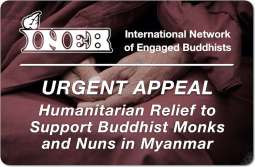Council of Pāṭaliputra. An early council mentioned only in Pāli sources and regarded by the Theravāda school as the ‘Third Council’. The council took place around 250 bce during the reign of Aśoka, and according to traditional accounts in the Mahāvaṃsa and Dīpavaṃsa the king played a leading role. The events centred on a monastery (vihāra) in Pāṭaliputra where certain residents refused to celebrate the poṣadha (Pāli, uposatha) ceremony with colleagues they regarded as lax and unorthodox. Aśoka dispatched an emissary to resolve the matter but he, misunderstanding his orders, had a number of monks executed. Aśoka then intervened and convened a council of 1000 monks under the presidency of a senior and learned monk named Moggaliputta Tissa. The orthodox teaching of the Buddha was identified as Vibhajjavāda, and one by one the monks were questioned by Aśoka and expelled if their views were non-Buddhist (e.g. if they held the doctrine of eternalism). The king then departed and the monks held their council (saṇgīti), or communal recitation of the texts. The king was thus not concerned with divergent views among the genuine Buddhist monks. Many of the unorthodox views are recorded in the Kathāvatthu. Aśoka's Edicts contain allusions to dissent in the Saṃgha, which may support the historicity of the traditional account.
Council of Pāṭaliputra I. The ‘Third Council’ at Pāṭaliputra c.350 bce is not an historical fact so much as a scholarly hypothesis developed to explain the ‘Great Schism’ between the ‘Elders’ (Sthaviras) and the ‘Great Assembly’ (Mahāsaṃghikas), which was to have a profound effect upon the later tradition. This council is not mentioned in any canonical sources, and is not recognised by the Theravāda, who identify the Third Council with a later council at the same place held in the reign of Aśoka (see Council of Pāṭaliputra II). The circumstances surrounding the ‘Third Council’ are somewhat unclear, and there are two alternative explanations for why it was called. One concerns five theses put forward by a monk named Mahādeva to the effect that the Buddha was greatly superior in wisdom and compassion to the Arhat. The Mahāsaṃghikas accepted these five points and emphasized the Buddha's compassion and supernatural qualities, while the Sthaviras rejected them and held to the notion of the Buddha's nature as essentially human. The two groups were unable to reach agreement and went their separate ways. This explanation, however, which comes from sources over 400 years after the event, is almost certainly incorrect. Recent research shows that the ‘five theses’ have nothing to do with the early Mahāsaṃghikas and therefore can have nothing to do with with the initial schism with the ancestors of the Theriya tradition.
A second explanation for the split is that the division was caused by an attempt by the Sthaviras to introduce additional rules into the Vinaya which the Mahāsaṃghikas refused to accept. Most probably the schism was the product of a number of disagreements concerning both doctrine and monastic practice.













